Kazakhstan
 From Rationalwiki
From Rationalwiki _-_KAZ_-_UNOCHA.svg.png)
“”We should not be afraid of humour and we shouldn't try to control everything.
|
| —Dariga Nazarbayev, a politician and the daughter of Kazakhstan President Nursultan Nazarbayev, responding to the film Borat.[1] |
Kazakhstan, also known as Russia's garbage dump, is the ninth largest country by land area and the largest landlocked country.[2][3][note 1] It shares borders with Russia and China, among others. It has a diverse array of ethnic groups, but most of the population follows Islam. Kazakhstan’s capital is Astana. The city was renamed Nur-Sultan to honor Kazakhstan’s longtime former dictator in 2019,[4] but then was renamed back to Astana in 2022.[5]
Kazakhstan’s steppe terrain was home to various nomadic groups, particularly Turkic nomads. The Kazakh language itself is a dialect of Turkish, which is why knowing Turkish could get a person from Europe to Imperial China on the Silk Road in ancient days and even to the modern era.[6] In the 13th century, stronger nomads led by Genghis Khan from Mongolia subjugated the entire region. The Mongols left, but the Kazakhs would face a new threat over the following centuries: Russia. Kazakhstan’s coal reserves proved valuable to the Russian Empire, and the succeeding Soviet Union saw things no differently. Under Soviet rule, exploitation became worse as Kazakhstan became a dumping ground for industrial and nuclear waste.
Unfortunately, not a whole lot changed when Kazakhstan gained independence in 1991. The old Soviet-era puppet leader, Nursultan Nazarbayev, remained in power for decades only to step down in 2019. His rule was just as corrupt and authoritarian as things had been under Moscow’s yoke. Kazakhstan today is stable and largely free from the scourge of Islamic terrorism, but political dissent can still be very dangerous.
Kazakhstan is also wealthier than its other Central Asian cousins, mainly due to its border on the oil-rich Caspian. It is also currently the largest producer of uranium globally and continues to expand production. Of course, wealth does not translate into freedom, and Kazakhstan still has a long way to go.
Historical overview[edit]
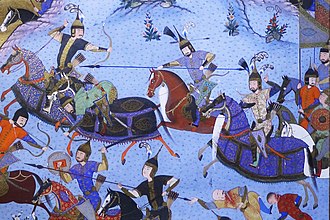
Early tribal history[edit]
Kazakhstan has been inhabited since the Paleolithic, and the people living there largely kept themselves to a nomadic pastoralist lifestyle.[7] This nomadism meant that organized states weren’t really a thing here for a long, long time. It’s hard to have a government when you’re moving around. The dominant culture group during this time was the Göktürks.[8]
The Göktürks, around 550 CE, created the first real organized state in Central Asia: the First Turkic Khaganate.[9] The state was governed by a ruler advised by a council, and sure enough, it fractured due to succession conflicts. Afterward, various Turkic tribal federations rose, including the Quarluqs, the Oghuz, and the Qarakhanids. This last group submitted to the military might of the Abbasid Caliphate, eventually leading the Turkic pagans to adopt Islam.[10] They then got conquered by yet more nomad hordes because that’s just how things went in the steppe.
This tumultuous history is a clear consequence of Kazakhstan’s nomadism and flat terrain. Borders weren’t a thing, and natural boundaries didn’t exist, meaning that states and hordes rose and fell all the time. Outside powers could temporarily maintain their rule here before the nomads became restless.
Mongol conquest and rule[edit]
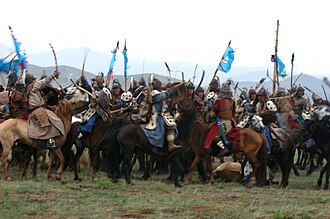
In 1130, the Turks came under attack from nomads from the further east. First came the Khitans, a Buddhist nomadic group driven west by a greater threat.[11] The Khitans took over Central Asia, but the people they had fled from weren’t far behind.
In 1218, the Mongol horde of Genghis Khan swept through. Their army numbered about 200,000.[11] Further south of Kazakhstan, the Mongols destroyed huge cities like Bukhara and Samarkand. Central Asia had no way to resist the invasion and thus quickly became part of the empire.
However, the Mongols were not immune from the old problems with ruling Central Asia. It was hard to make the nomads fall in line, and the Mongol Empire soon dissolved due to succession disputes. Most Central Asia went to Jochi Khan, who founded the Golden Horde. This Mongol successor state predictably came under immediate attack from other Mongol successor states and nomad powers.
Through trade and cultural connections, the Golden Horde became further Turkified and Islamized, while subject peoples like the East Slavs and Caucasian peoples were forced to give tribute to the nomad overlords.[12] The Black Plague, which struck in the mid-1300s, marked the beginning of the end for the Mongol successor state. With many of its best warriors killed by disease, the Golden Horde lost wars against the rebellious Russian princes and Turkic warlords further south.[12] These attacks caused the Golden Horde to split into smaller khanates, with the Mongol state disintegrating entirely by 1502.
Kazakh Khanate[edit]
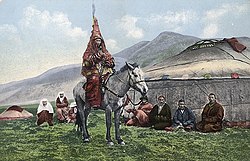
The splitting of the Golden Horde finally resulted in the first instance in which the Kazakh people became their own nation-state. Around 1511, Khan Kasym united the various Kazakh tribes into one polity based on their Kazakh culture and language.[13]
Although based on a Kazakh identity, the khanate wasn't much different from the nomad empires before. The old problems with ruling Central Asia came back with a vengeance. They were sandwiched between the hostile Nogai horde to the west and the Dzhungars to the east, and Kazakhstan's terrain gave them no real means of practical defense.[14] The Kazakh-Dzungar Wars lasted more than a century between 1643 and 1756, and the Kazakhs only came out on top at great cost to their own population.[15] This weakened the Kazakh Khanate at a crucial moment when the Russian Empire started making inroads into Central Asia.
Again, in history and contemporary politics, you'll notice that being at war for long periods tends to harm society.
Kazakh vs. Cossack[edit]
We're about to talk a lot about Cossacks and Kazakhs, and it might help to mention the pronunciation, to help some users keep them separate in their heads. Cossack, of course, is pronounced COSS-ack, and Kazakh is sometimes mispronounced COSS-ock or COZZ-ock, which is confusing. A more proper pronunciation of Kazakh is ka-ZAKH, with emphasis on the second syllable and the KH being a gutteral sound like the j in Spanish or ch in German.
Russian conquest and rule[edit]
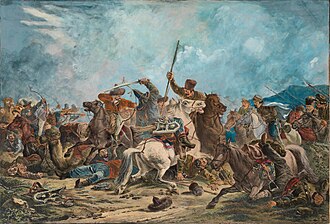
Russian traders and soldiers, shielded by the Cossacks, began building forts in Kazakh territory and taking chunks of land in localized conflicts. The Kazakhs were too preoccupied with their wars to do anything about this, and then they subsequently split into three smaller hordes due to, sigh, succession disputes. At first, the Russians were only trying to prevent Kazakh mounted raids, but their aims soon became more acquisitive.[16] With the British Empire expanding northwards through India and towards Afghanistan, it became a race between the two powers to gobble up as much Central Asian territory as possible to keep the other power from benefiting.[17]
This period of imperialist competition was called the "Great Game." It was no game for the Kazakhs, however. The Russian Empire conquered the Middle Horde in 1798, leaving Kazakhstan split up and vulnerable.[13] They did this relatively simply by relying on deceit; Russian officials would broker alliances with local Kazakh khans and then move troops into Kazakh territory and never leave.[18] Russia completed its slow but safe conquest by 1845.
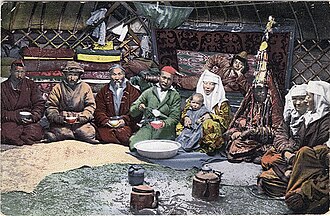
Once realizing that they were in danger of being fully annexed, the Kazakhs rose up repeatedly against Russian control. The first mass uprising was led by Khan Kene (called Kenisary Kasimov by the Russians), who fought an insurgency against Russia for eleven years between 1836 and 1847.[13] These uprisings would eventually be put down by superior Russian manpower and resources.

Kazakhstan became part of the new Russian "Steppe District", and Russia exerted its control by building forts all over the place to restrict Kazakh nomadic movements. This had a terribly destructive impact on the Kazakh way of life and economy because the Kazakhs could no longer drive their herds and seek new grazing land freely.[19] Russia also stripped all Kazakh khans and lords of their titles, declaring that Kazakhstan would be a mere colony.[18] Huge numbers of Russian settlers arrived in the region, encouraged by the Russian government with land grants. Naturally, these land grants consisted of all of the best Kazakh land, which had been carelessly appropriated from the Kazakh people.[18] Between 1906 and 1912, more than a half-million Russian farms were started as part of the reforms of the Russian minister of the interior Petr Stolypin, shattering what remained of the traditional Kazakh way of life. Many thousands of Kazakhs died in revolts and famines.
Kazakhstan also sucked for many Russians since the tsarist government used it as a gulag dumpster for unwanted political nonconformists, much like the Brits used Australia for their prisoners. Prisoners exiled to Kazakhstan included Fyodor Dostoyevsky, Ukrainian poet Taras Shevchenko, and even Leon Trotsky.[18]
The starving and displaced Kazakh people had no reason to feel loyalty to the Russian Empire. When Russia tried conscripting people from Central Asia to fight in World War I, the Kazakhs joined the wider Basmachi movement to violently resist being sent off to fight for their oppressors.[20] The Basmachi movement resulted in thousands of deaths and many horrific massacres, and it soon became part of the greater Russian Civil War.
Alash Autonomy and the Russian Civil War[edit]
The Russian government collapsed utterly in 1917, giving the Kazakhs what seemed like a golden opportunity to reclaim independence. Just about a month after that, the Kazakh people declared themselves independent and named their state the Alash Autonomy. Unfortunately for them, the Autonomy was not actually autonomous. Most of its territory was controlled by the Russian White Army, and the Alash leaders had to play nice if they wanted to keep so much as the claim to independence.[21]
Even worse, the Red Army was just over the corner. After taking control of Russia, Vladimir Lenin was forced to surrender vast tracts of territory to buy peace with the German Empire, but he wasn't about to let Kazakhstan go. The Red Army's relentless assault caused the Alash state's collapse by 1920. Exacerbating miserable conditions was a devastating drought combined with the burdens of war against the Red Army, which caused a famine that killed somewhere between half and three-quarter million people.[22] Sadly, that wouldn't be the last or the worst famine to hit Kazakhstan.
.jpg)
The Soviets replaced the Alash Autonomy first with the Kyrgyz Autonomous Soviet Socialist Republic and then renamed it the Kazak Autonomous Soviet Socialist Republic. Even worse times were ahead.
Soviet rule[edit]
Famine[edit]
The Soviets really started cracking down when Joseph Stalin came into power. Stalin's experiment in collectivized agriculture was a disaster in Kazakhstan, causing a horrific man-made famine akin to the Holodomor. The famine, caused mainly by food confiscations, killed about 2 million people, representing a third of the ethnic Kazakh population.[23]
Many factors exacerbated this famine's impact on the Kazakh people. Firstly, they had recently suffered famine and had for much longer suffered the complete destruction of their traditional way of life under the Russian Empire. The Soviets also used their collectivization policy to rebuild and "modernize" Kazakh culture by forcing them to abandon nomadism and force them to partake in brutal collective farms.[24] It's also notable that the Soviets barely reacted to the famine in Kazakhstan.
All in all, it's hard to deny that Stalin was a colossal piece of shit, so don't even try it.
WWII and development[edit]
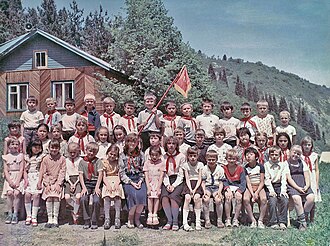
Despite the horrific atrocity heaped upon them, the Kazakhs and their land became an integral part of saving the Soviet Union during World War II. With much of the country's European land overrun, Stalin ordered factories and laborers to relocate to Central Asia, especially Kazakhstan.[25] Once again, Kazakhstan became a dumping ground for undesirables, ethnic Germans, Poles, and Tatars, whom the Stalinist government feared would be disloyal.[26] Authoritarians gonna authoritarian.
Kazakhstan, which had become its own Soviet republic in 1936, became increasingly important to the overall Soviet Union. Soviet leader Nikita Khrushchev in 1953 announced the Virgin Lands campaign, which aimed to dramatically increase Soviet food production.[27] Under that program, vast tracts of Kazakh grazing land were put to the plow to cultivate wheat and other cereal grains. Settlers from other parts of the Soviet Union, as well as Koryo-saram![]() who had nowhere else to go, got benefits from the government to encourage them to move in. It was basically just more colonization but under a red flag this time.
who had nowhere else to go, got benefits from the government to encourage them to move in. It was basically just more colonization but under a red flag this time.
Throughout the late 1960s and 1970s, the Soviet government found out that Kazakhstan actually sits on a shitload of oil and natural gas reserves. Cha-ching! Cue more settlers and more industrial development.
Ecological catastrophes[edit]
“”Decay and desolation scar the landscape of a remote corner of the Kazakh Steppe. Unnatural lakes formed by nuclear bomb explosions pockmark the once flat terrain, broken up only by empty shells of buildings. It appears uninhabitable. And yet, ghosts – living and dead – haunt the land, still burdened by the effects a nuclear testing program that stopped nearly 30 years ago.
|
| —Alexandra Genova, writing for the National Geographic in 2017.[28] |
Perhaps the most enduring legacy of Soviet rule in Kazakhstan is felt through the nuclear waste that still riddles Kazakhstan's landscape. As both the United States and the Soviet Union raced to develop nuclear weapons during the Cold War, Kazakhstan became the Soviet Union's primary testing ground. They conducted no less than 456 nuclear tests at the Semipalatinsk Test Site in Kazakhstan, showing complete disregard for the impact on the local population.[29] Tests continued until 1989, exposing as many as 1.5 million people to dangerous radiation levels.[30] Not only were Kazakhs exposed to immediate blast radiation, but radioactive dust kept blowing across the country for decades.
The Soviets also exposed 60 million people in Kazakhstan to what former UN Secretary-General Ban Ki-moon called "one of the planet’s worst environmental disasters" by completely destroying the Aral Sea.[31] By rerouting rivers for agricultural projects and dumping pollution, the Soviets literally made the Aral Sea evaporate and disappear, destroying the nearby Kazakh communities' primary source of food and welfare.[32]The place is a desert now, with vast plains once used for WMD testing and as a dumping ground for pesticides, industrial waste, and fertilizers. People living near the Aral Sea (or what's left of it) are regularly exposed to deadly toxins as the polluted desert sands blow across Central Asia.[33]
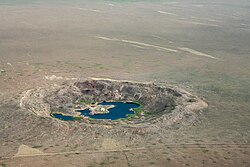
Crater from a Soviet nuclear test at Semipalatinsk, photographed in 2008.
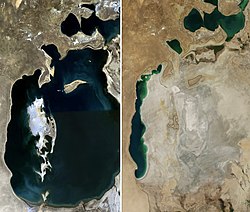
The Aral Sea in 1989 vs. 2014.
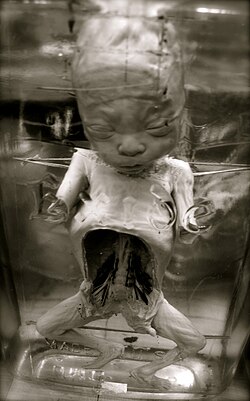
A human fetus affected by radiation from Semipalatinsk.
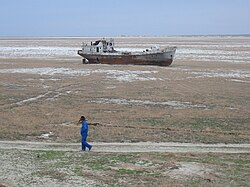
Shipwreck in what used to be the Aral Sea, near Aral, Kazakhstan.
Independence and the rise of Nazarbayev[edit]
Kazakhs finally started to get fed up with Soviet misrule in the 1980s. The gradual realization that Soviet nuclear tests had fucked everyone over there played into it with the formation of the eventually very powerful anti-nuclear movement in Kazakhstan.[34] In December 1986, Soviet premier Mikhail Gorbachev ousted Kazakh Dinmukhamed Kunayev for being a corrupt piece of shit.[35] However, Gorby then fucked it up by replacing him with an ethnic Russian, which sparked protests among the Kazakh people. Soviet authorities responded to those protests by massacring hundreds of people, which didn't exactly win them much goodwill from the Kazakhs.[36]
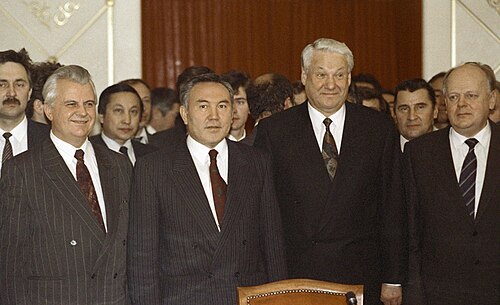
Kazakhstan's economy had also suffered from the general Soviet stagnation, making things ripe for popular unrest. Kazakh nationalists assembled informal political groups, and riots became more and more intense throughout the late '80s. In 1989, the central government finally caved, replacing the Russian with an ethnic Kazakh to lead the republic. The new boss was Nursultan Nazarbayev, who cynically portrayed himself as a Kazakh nationalist while still loyal to the Party.[37] Nazarbayev spent his time as a Soviet leader treading a narrow line between Moscow and his own people. He made Kazakh the republic's official language for the first time and allowed greater expressions of the Islamic faith.[37]
In March 1990, Nazarbayev held Kazakhstan's first elections, which confirmed him as the republic's leader and left his cronies in power. In June of the same year, Boris Yeltsin got Russia to declare its sovereignty within the Soviet Union. Throughout 1991, Nazarbayev became the last regional Soviet leader supporting the Union's continuing.[38] That was mainly because he wasn't convinced that Kazakhstan could stand on its own economically without the rest of the Soviet Union.
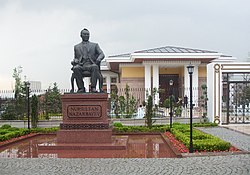
Because of the coup attempted by Moscow hard-liners against the Gorbachev government in August 1991, it became clear to everyone that the Soviet Union was dead. Nazarbayev pragmatically began preparing his republic for eventual independence by hiring economists and shaking hands with foreign resource development people. He also personally took control of much of Kazakhstan's state-run industries, hoping to remain Kazakhstan's leader by becoming indispensable.[38]
Without consulting any other republics, the leaders of Russia, Ukraine, and Belarus signed documents dissolving the Soviet Union in late 1991. Nazarbayev seemed ready to create a confederation of Turkic states to oppose the Slavic states because of their unilateral action. Instead, the Slavic leaders met with Nazarbayev and negotiated the Alma-Ata Protocol, creating the Commonwealth of Independent States to manage their future cooperation.[39] The treaty was signed in Kazakhstan shortly after the Soviet Union's downfall.
Dictatorship[edit]
After achieving independence, Kazakhstan simply made Nursultan Nazarbayev its new president. And until very recently, that's where things have stood.
Nazarbayev maintained a veneer of legitimacy for thirty years by dutifully holding elections, but they've always been rigged to ensure his victory.[40] He also granted himself the title of "Yelbasy", meaning head of the nation. He had many personal rights like permanent immunity from prosecution, permanent financial secrecy, and the requirement that he be consulted on all political matters. Nazarbayev actually still holds this title despite his recent resignation.
Nazarbayev's remarkable political longevity came from many factors. The primary one was and is his political allies. Nazarbayev carefully maintained good relations with the United States. He used the oil trade and its profits to ensure that the US would look the other way at his myriad abuses of human rights.[41] His position is also comfortable because of Kazakhstan's relative prosperity. His stable rule and the oil trade have ensured that no one is poor or desperate enough to really try challenging him.
In early 2019, though, Nazarbayev chose to resign his position as president of Kazakhstan. He carefully orchestrated his succession by ensuring that the vote would place his trusted second-in-command Kassym-Jomart Tokayev into power.[42] Sure enough, Tokayev won the election overwhelmingly. Nazarbayev also still looms large over Kazakhstan's politics. His toady Tokayev's first move was to rename Kazakhstan's capital Astana to be Nur-Sultan.[43]
Human rights[edit]
Freedom of speech and assembly[edit]
The right to assembly effectively doesn't exist in Kazakhstan, as the authorities must approve protests, and the authorities just won't approve any protests.[44] People who hold protests anyway are fined heavily and detained for long periods without food, water, or due process. More recently, Kazakhstan used COVID-19 as an excuse to pass a law permanently restricting any rights to peacefully assemble.[45]
In terms of media, most media outlets are controlled by the government or by state-friendly actors. The government harasses and forcibly shuts down any independent outlets or journalists.
Additionally, speech is highly regulated. Insulting the president or any government official is a criminal offense. In September 2019, newspaper editor Amangeldy Batyrbekov was sentenced to 27 months in prison for insulting a local education official on Facebook.[46]
Torture and mistreatment[edit]
People kept in Kazakhstan's prisons face torture and other mistreatment, which is considered routine. Torture is not considered a severe problem by Kazakhstan's authorities, though. Almost all of the many torture allegations brought to the government's attention are discarded. This is because torture allegations are investigated by either the police or a government "anti-corruption" office, which is corrupt.[44]
Environmental problems[edit]
.jpg)
Kazakhstan's natural environment has been catastrophically damaged by human activities, mainly by the Soviet Union. The Soviet Union conducted hundreds of nuclear tests on Kazakh soil, leaving behind a legacy of irradiation and genetic damage. Soviet irrigation experiments and industrial pollution have turned the Aral Sea into a critically dangerous desert region that spreads toxic dust over nearby settlements. As the Aral Sea shrank, its increasing salinity and toxicity killed off all the fish, leaving nearby fishing settlements shit out of luck.[47]
Water in Kazakhstan is hard to come by since most of the country's water sources are polluted with industrial waste and, in some places, radiation. The loss of water has had a great impact on Kazakhstan's temperatures, harming Kazakhstan's agriculture industry.[47] Agriculture is also hampered by the toxic soil blowing off the Aral Sea and nuclear test sites; this soil lands on crops and fields, killing and sterilizing them.[47]
Even though these problems began under the Soviet Union, the Kazakh government hasn't done much to stop pollution from its mining and industries. It's still happening to this day.
Science and technology[edit]
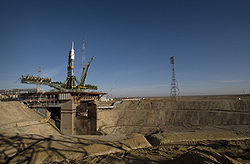
Baikonur Cosmodrome[edit]
A notable place in Kazakhstan is the Baikonur Cosmodrome, the site used to launch most rockets in the Soviet and Russian space programs. The launch complex was where Sputnik 1, Earth's first artificial satellite, was launched and where Yuri Gagarin, the first human in orbit, was also launched.[48]
It hosted many Soviet ICBMs, but they have since been transferred to Russia. This makes Kazakhstan one of four countries with the status of former nuclear power (the others being Belarus, Ukraine (both for the same reason), and South Africa). The spaceport and its grounds (including the town of Baikonur) are administered by Russia, as they have rented it to at least 2050. Spent first stages fall in the steppes downrange and end up scavenged by Kazakh scrap-metal hunters.[49]
For now and until private space flight becomes more common, NASA is effectively the Cosmodrome's bitch for its manned spaceflight program. The Space Shuttle's retirement in 2011 has left Soyuz![]() rockets the only consistent way to travel to the International Space Station.
rockets the only consistent way to travel to the International Space Station.
The name "Baikonur" is a misnomer, as the site is about 322 kilometers (200 miles) southwest of the actual town called Baikonur.[48] The Soviet Union did this intentionally to make it harder for their enemies to locate the launch complex. The true location is now international knowledge, but the name has stuck.
Gallery[edit]
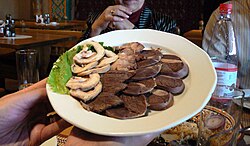
Horse meat platter.
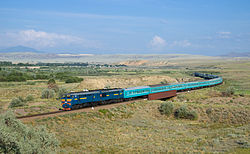
Railroad on the Kazakh steppe.
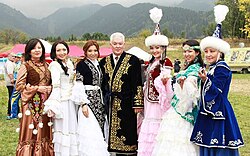
Kazakh family in traditional dress.
See also[edit]
- Kyrgyzstan
- Turkmenistan
Notes[edit]
- ↑ Kazakhstan's coast on the Caspian Sea doesn't count since that's just a great big lake that doesn't connect to an ocean.
References[edit]
- ↑ Daughter of Kazakhstan's president defends Borat. CBS.ca.
- ↑ The World’s Top 10 Largest Countries, Mappr, January 31, 2021
- ↑ Largest Landlocked Nations in the World, WorldAtlas
- ↑ Kazakhstan renames capital to honour ex-leader. Al Jazeera.
- ↑ "The Capital Has Been Officially Renamed to Astana", The Qazaqstan Monitor, 18 September 2022
- ↑ The Silk Road Across Turkey. Eastern Turkey Tours.
- ↑ Ikawa-Smith, Fumiko (1 January 1978). Early Paleolithic in South and East Asia. Walter de Gruyter. p. 91. ISBN 978-3-11-081003-5.
- ↑ See the Wikipedia article on Göktürks.
- ↑ See the Wikipedia article on First Turkic Khaganate.
- ↑ Kazakhstan: Early Tribal Movements. '‘ Country Studies.
- ↑ 11.0 11.1 History in Kazakhstan. Lonely Planet.
- ↑ 12.0 12.1 Golden Horde. Britannica.
- ↑ 13.0 13.1 13.2 Kazakhstan: Forming the Modern Nation. Country Studies.
- ↑ See the Wikipedia article on Kazakh Khanate.
- ↑ See the Wikipedia article on Kazakh-Dzungar Wars.
- ↑ "Central Asia, 130 Years of Russian Dominance: A Historical Overview". Edward A. Allworth, Edward Allworth (1994). Duke University Press. p. 10. ISBN 0822315211
- ↑ See the Wikipedia article on The Great Game.
- ↑ 18.0 18.1 18.2 18.3 Russians Take Kazakhstan. Facts and Details.
- ↑ Kazakhstan: Russian Control. Country Studies.
- ↑ See the Wikipedia article on Basmachi movement.
- ↑ See the Wikipedia article on Alash Autonomy.
- ↑ See the Wikipedia article on Kazakh famine of 1919–1922.
- ↑ See the Wikipedia article on Kazakh famine of 1932–33.
- ↑ The Kazakh Famine of the 1930s. Library of Congress. John W. Kluge Center.
- ↑ Kazakhstan in the Soviet Union. Country Studies.
- ↑ Kazakhstan. World War II Database.
- ↑ See the Wikipedia article on Virgin Lands campaign.
- ↑ This Is What Nuclear Weapons Leave in Their Wake. National Geographic.
- ↑ See the Wikipedia article on Semipalatinsk Test Site.
- ↑ The nuclear sins of the Soviet Union live on in Kazakhstan. Nature.
- ↑ How the Soviet Union Created Central Asia’s Worst Environmental Disaster. The Diplomat.
- ↑ How Soviet pollution destroyed the Aral Sea. BBC News.
- ↑ O'Hara, Sarah; Wiggs, Giles; Mamedov, Batyr; Davidson, George; Hubbard, Richard (19 February 2000). "Exposure to airborne dust contaminated with pesticide in the Aral Sea region". The Lancet. 355 (9204): 627–628. doi:10.1016/S0140-6736(99)04753-4. PMID 10696990.
- ↑ See the Wikipedia article on Anti-nuclear movement in Kazakhstan.
- ↑ Kazakhstan: Reform and Nationalist Conflict. Country Studies.
- ↑ See the Wikipedia article on Jeltoqsan.
- ↑ 37.0 37.1 The Rise of Nazarbayev. Country Studies.
- ↑ 38.0 38.1 Kazakhstan: Sovereignty and Independence. Country Studies.
- ↑ See the Wikipedia article on Alma-Ata Protocol.
- ↑ Change or more of the same? Kazakhstan's pivotal presidential election explained. Euronews.
- ↑ The world's enduring dictators: Nursultan A. Nazarbayev, Kazakhstan. CBS News.
- ↑ An Aging Autocrat’s Lesson for His Fellow Dictators. The Atlantic.
- ↑ Nursultan: Kazakhstan renames capital Astana after ex-president. BBC News.
- ↑ 44.0 44.1 Kazakhstan. Amnesty International.
- ↑ Kazakhstan: Authorities Rush to Further Limit Peaceful Assembly. Freedom House.
- ↑ Kazakhstan. Freedom House.
- ↑ 47.0 47.1 47.2 Kazakhstan: Environment. Country Studies.
- ↑ 48.0 48.1 Baikonur Cosmodrome. NASA.
- ↑ As seen in the trailer of the Space Tourist documentary and this Slate photo gallery.
Categories: [Asian countries] [Authoritarian regimes] [Environment]
↧ Download as ZWI file | Last modified: 11/07/2025 19:41:31 | 95 views
☰ Source: https://rationalwiki.org/wiki/Kazakhstan | License: CC BY-SA 3.0

 KSF
KSF